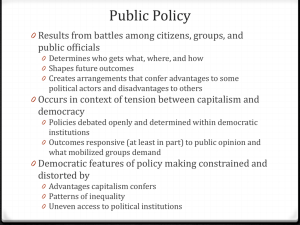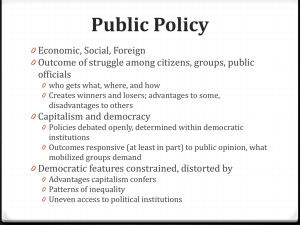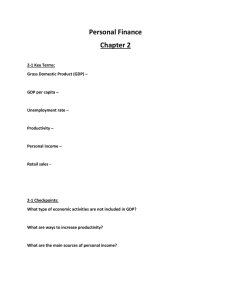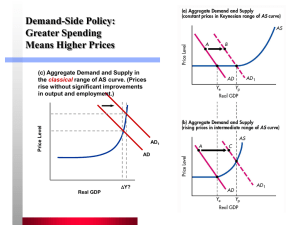Alternative choices over the future spending squeeze Rowena Crawford
advertisement
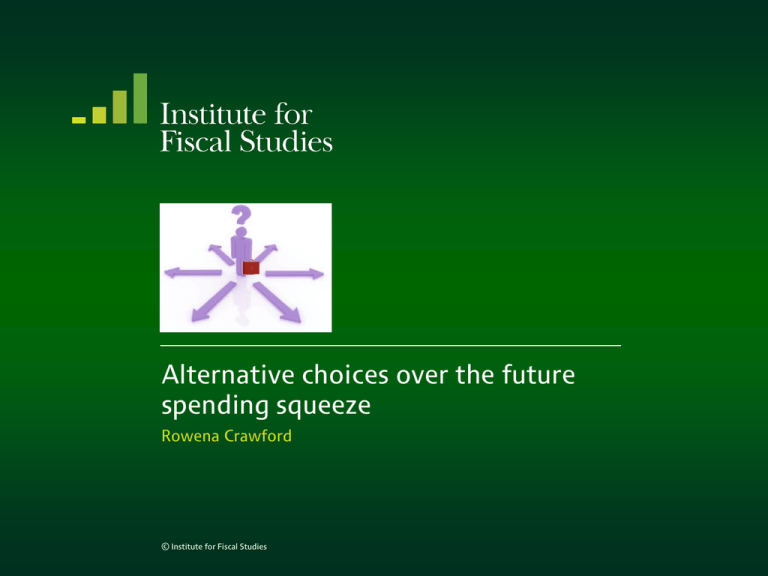
Alternative choices over the future spending squeeze Rowena Crawford © Institute for Fiscal Studies Progress to date • How much of the planning spending cut has been achieved to date depends on the definition used • Prime Minister has favoured “Total spending less debt interest” focussing on a £25bn cut over 2016–17 and 2017–18 – on the same basis now a £30bn cut over those two years – more importantly a £38bn cut over five years to 2019–20 – compares to £11bn cut over four years to 2014–15, so only 23% of the planned 2010–11 to 2019–20 cut done by end 2014–15 – in part due to faster growth in pensioner benefits over the earlier period • We will focus on “Departmental Expenditure Limits” (DEL) – essentially spending by Whitehall departments on admin and services – 39% of the planned 2010–11 to 2019–20 cut done by end 2014–15 © Institute for Fiscal Studies Planned and implied departmental spending Real departmental spending (indexed to 100 in 2010-11) 110 This parliament (10-11 to 14-15): -2.2% average annual cut -8.6% cumulative cut 100 90 80 70 60 50 © Institute for Fiscal Studies Nine years of consolidation -2.8% average annual cut -22.2% cumulative cut Outturn Allocated between departments Yet to be allocated Next parliament (14-15 to 19-20): -3.2% average annual cut -14.9% cumulative cut Planned and implied departmental spending Real departmental spending (indexed to 100 in 2010-11) 110 “Allocated period” (10-11 to 15-16): -2.0% average annual cut -9.5% cumulative cut 100 90 80 70 60 50 © Institute for Fiscal Studies “Unallocated period” (15-16 to 19-20): -3.7% average annual cut Outturn -14.1% cumulative cut Allocated between departments Yet to be allocated Some departments faring particularly badly • NHS, aid and schools (non-investment) spending have been relatively protected Real % change • Other areas have therefore fared worse than total DEL figures imply: 10 0 -10 -20 -30 -40 -50 Total DEL 6.5 'Protected' areas 'Unprotected' areas 6.5 0.0 -9.5 -19.9 -14.1 -26.3 -22.2 -41.0 Allocated period Unallocated period Total consolidation (2010-11 to 2015-16) (2015-16 to 2019-20) (2010-11 to 2019-20) © Institute for Fiscal Studies 1949-50 1952-53 1955-56 1958-59 1961-62 1964-65 1967-68 1970-71 1973-74 1976-77 1979-80 1982-83 1985-86 1988-89 1991-92 1994-95 1997-98 2000-01 2003-04 2006-07 2009-10 2012-13 2015-16 2018-19 Percentage of total national income (%) The changing size of the state 60 50 40 30 TME 20 10 TME less debt interest 0 Sources: EFO December 2014, ONS © Institute for Fiscal Studies 1949-50 1952-53 1955-56 1958-59 1961-62 1964-65 1967-68 1970-71 1973-74 1976-77 1979-80 1982-83 1985-86 1988-89 1991-92 1994-95 1997-98 2000-01 2003-04 2006-07 2009-10 2012-13 2015-16 2018-19 Percentage of total public spending (%) The changing role of the state 20 18 16 14 12 10 8 6 4 2 0 Health State pension Debt interest © Institute for Fiscal Studies Sources: PESA 2014, DWP Benefit Expenditure tables 2014, EFO December 2014, ONS Planned and implied departmental spending Real departmental spending (indexed to 100 in 2010-11) 110 100 Outturn Allocated between departments Yet to be allocated 90 80 70 60 50 © Institute for Fiscal Studies “Unallocated period” (15-16 to 19-20): -3.7% average annual cut -14.1% cumulative cut How could future tax increases/welfare spending cuts change the picture? Tax increase or social security spending cut, £ billion (2015–16 terms) 50 Total DEL 45 40 35 30 25 20 15 10 5 0 -5 -10 -20% -15% -10% -5% 0% Real change in departmental spending, 2015–16 to 2019–20 © Institute for Fiscal Studies 5% How could future tax increases/welfare spending cuts change the picture? Tax increase or social security spending cut, £ billion (2015–16 terms) 50 Total DEL 45 No further real DEL cut: Would require £47 billion welfare cuts/tax increase 40 35 30 25 20 DEL cut at same average annual rate as over 2010-11 to 2015-16: Would require £21 billion welfare cuts/tax increase 15 10 5 0 -5 -10 -20% Current coalition plans -15% -10% -5% 0% Real change in departmental spending, 2015–16 to 2019–20 © Institute for Fiscal Studies 5% Some possible alternative scenarios “Coalition policy” “Same rate DEL” “Osborne max” £21bn additional welfare cut / tax rise “£12 bn additional welfare cut” “£7.2 bn tax cut” Real % cut 2015-16 to 2019-20 0 -5 -7.7 -10 -15 -14.1 -14.3 -20 -25 -26.3 -30 Total DEL © Institute for Fiscal Studies 'Unprotected' DEL Some possible alternative scenarios “Coalition policy” “Same rate DEL” “Osborne max” “Current budget balance” PSNB = -1.0% GDP PSNB = -1.0% GDP PSNB = 0% GDP PSNB =1.2% GDP £21bn additional welfare cut / tax rise “£12 bn additional welfare cut” No net change to welfare/ tax “£7.2 bn tax cut” Real % cut 2015-16 to 2019-20 0 -1.3 -2.3 -5 -10 -15 -6.6 -7.7 -12.3 -14.1 -14.3 -20 -25 -26.3 -30 Total DEL © Institute for Fiscal Studies 'Unprotected' DEL Some possible alternative scenarios “Coalition policy” “Same rate DEL” “Osborne max” “Current budget balance” PSNB = -1.0% GDP PSNB = -1.0% GDP PSNB = 0% GDP PSNB =1.2% GDP £21bn additional welfare cut / tax rise “£12 bn additional welfare cut” No net change to welfare/ tax “£7.2 bn tax cut” Real % cut 2010-11 to 2019-20 0 -5 -10 -10.6 -15 -25 -15.4 -16.4 -20 -21.8 -22.2 -30 -31.4 -35 -29.8 -40 -45 -41.0 Total DEL © Institute for Fiscal Studies 'Unprotected' DEL The cost of higher borrowing • Any additional spending financed from higher borrowing would result in higher debt and a greater proportion of spending going on debt interest spending • Running a current budget surplus (borrowing 1.2% GDP) from 2017-18 onwards rather than coalition plans and zero borrowing in 2019-20 would result in: – 2.4% national income higher debt in 2020-21 – £1.5 billion higher debt interest payments (2015-16 terms) • Impact would be larger if higher levels of borrowing are maintained in the longer term – E.g. see HMT projections in chart 1.9 (p27) of Autumn Statement © Institute for Fiscal Studies Summary • Current coalition plans imply large cuts to departmental spending still to come – Cumulative cuts over whole consolidation could reach 22% for all departmental spending, and 41% for unprotected areas • Cuts beyond 2015-16 could be reduced by further welfare spending cuts, tax increases and/or higher borrowing • Tory, Labour and Lib Dem fiscal rules all allow for greater borrowing than currently forecast under coalition policy – Tories to a lesser extent than Labour/Lib Dems as aiming for zero borrowing rather than borrowing up to amount spent on investment • Any additional spending financed from higher borrowing would result in higher debt and a greater proportion of spending going on debt interest spending – Impact would be relatively small up to 2019-20; would be larger if higher levels of borrowing are maintained in the longer term © Institute for Fiscal Studies Some possible alternative scenarios (£bn figures) “Coalition policy” “Same rate DEL” “Osborne max” “Current budget balance” PSNB = -1.0% GDP PSNB = -1.0% GDP PSNB = 0% GDP PSNB =1.2% GDP £21bn additional welfare cut / tax rise “£12 bn additional welfare cut” No net change to welfare/ tax Real £cut 2015-16 to 2019-20 (£ billion, 2015-16 prices) “£7.2 bn tax cut” 0 -4.6 -4.6 -10 -20 -24.0 -24.0 -30 -27.9 -27.9 -40 -50 -51.4 -51.4 -60 Total DEL © Institute for Fiscal Studies 'Unprotected' DEL Some possible alternative scenarios (£bn figure) “Coalition policy” “Same rate DEL” “Osborne max” “Current budget balance” PSNB = -1.0% GDP PSNB = -1.0% GDP PSNB = 0% GDP PSNB =1.2% GDP £21bn additional welfare cut / tax rise “£12 bn additional welfare cut” No net change to welfare/ tax “£7.2 bn tax cut” Real cut 2010-11 to 2019-20 (£billion, 2015-16 prices) 0 -20 -40 -42.8 -60 -53.1 -80 -100 -62.2 -66.1 -76.4 -72.5 -89.5 -99.8 -120 Total DEL © Institute for Fiscal Studies 'Unprotected' DEL

